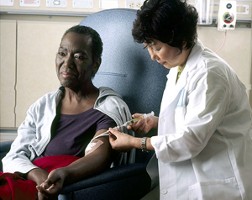24 February 2015. Medical and engineering researchers at University of California in Los Angeles designed a system that generates a personalized combination of drugs, including medicines with nanodiamonds, to treat metastatic cancer. The team led by Dean Ho from UCLA’s dentistry school and Chih-Ming Ho, a professor of mechanical engineering, published its findings last week in the journal ACS Nano (paid subscription required).
The UCLA researchers sought a solution for treating people with advanced cancer that metastasizes, or spreads to other parts of the body, and who often receive simultaneous combinations of drugs to overcome resistance to single drugs. Even with genetic information to guide the choice and dosages of drugs, mutations in tumors can limit or negate the drugs’ effectiveness.
“Drug combinations are conventionally designed using dose escalation,” says Dean Ho in a university statement. “Until now, there hasn’t been a systematic way to even know where the optimal drug combination could be found, and the possible drug-dose combinations are nearly infinite.”
The team aimed to provide a more systematic way process for assembling a personalized cancer drug combination that accounts for the properties and complexity of tumors, as well as drug efficacy and toxicity. In addition, the process was designed to accommodate advances in nanomedicine, where adding nanodiamonds to compounds increases the ability of drugs to bind to tumor cell surfaces, a specialty of study co-leader Dean Ho. The added binding power increases the exposure of drugs to the cancer targets, boosting their efficacy and making possible lower dosages.
The UCLA researchers adapted a system known as Feedback System Control developed in Chih-Ming Ho’s engineering lab that studies control mechanisms in complex biological systems. The team modified Feedback System Control to analyze phenotypes or physical traits of cells along with drug efficacy and toxicity to determine optimal drug combinations.
The team tested combinations of current cancer drugs doxorubicin, mitoxantrone, bleomycin, and paclitaxel on breast cancer cell lines in the lab. The tests included various combinations with three of the drugs boosted with nanodiamonds and the fourth drug in its original state. The researchers also treated non-cancer cell lines with the drugs as indicators of safety. The tests covered single drugs against drug combinations, nanodiamond-boosted drugs compared to unmodified drugs, and random combinations of drugs versus combinations recommended by Feedback System Control.
The results show optimized drug combinations with nanodiamonds recommended by Feedback System Control were safer and more effective against cell lines than optimized combinations of original drugs. In addition, system-recommended drug combinations with nanodiamonds outperformed drugs combined randomly.
The authors say this system can be extended to disorders other than cancer. “This optimized nanodrug combination approach can be used for virtually every type of disease model and is certainly not limited to cancer,” says Chih-Ming Ho, adding, “this study shows that we can design optimized combinations for virtually every type of drug and any type of nanotherapy.”
Read more:
- Thyroid Cancer Drug Approved by FDA
- Cancer Progress Indicators Devised
- Early Trial Underway Testing Brain Cancer Drug
- Nanomedicine Developer Secures $7.5M Venture Funds
- Analytics, Genomics Companies Partner on Cancer Therapies
* * *


 RSS - Posts
RSS - Posts
You must be logged in to post a comment.